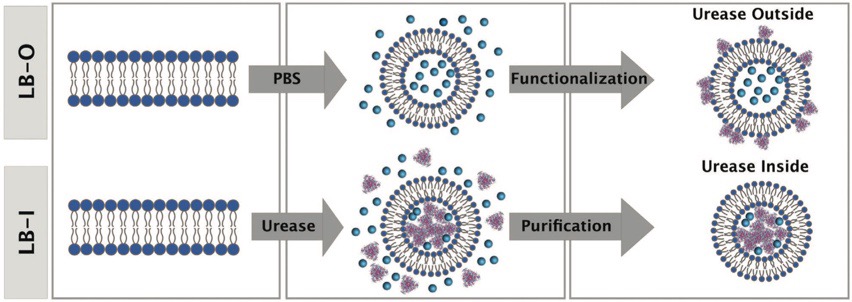Friday, 04 September 2020
More robust nanomotors for drug delivery developed with nano-encapsulation technologies
Researchers from the Institute for Bioengineering of Catalonia (IBEC) and the Catalan Institute of Nanoscience and Nanotechnology (ICN2) have developed a novel type of encapsulated enzymatic nanomotors, named LipoBots, for medical applications. As explained in a paper published in Advanced Functional Materials, the LipoBots are self-powered and preserve their enzymatic functionalities after exposure to harsh conditions, as those of the human stomach environment.

Catalytic nanomotors, which are nanostructures able to harvest chemical energy from their surroundings and use it to move around, are demonstrating great potential for biomedical applications. They are very attractive, indeed, since they can be “switched on” and made operative in situ using various biomolecules as fuel. This propelling mechanism allows the nanomotors to diffuse over larger volumes compared to their passive counterparts and, thus, to easily reach a specific target, penetrate tissues and perform drug delivery with better performance.
Enzymes are ideal candidates to act as sources of catalytic power for nanomotors to be used in the biomedical field, since they are highly diverse, substrate-specific and, most of all, are present everywhere in the human body. In living organisms, though, these enzyme-powered nanostructures can be exposed to harsh conditions, such as strong variations of the pH, which could compromise both their motion and chemical functionalities.
A team of researchers from the ICN2 Supramolecular Nanochemistry and Materials group, led by ICREA Prof. Daniel Maspoch, and from the Smart Nano-Bio-Devices group of the Institute for Bioengineering of Catalonia (IBEC), headed by ICREA Prof. Samuel Sanchez, have developed self-powered enzymatic nanomotors that preserve their functionalities after being exposed to different acidic pH's thanks to enzyme encapsulation. They have demonstrated the validity of this approach on a novel type of nanomotors, named LipoBots (LBs), powered by urease. This study, led by Prof. Sanchez and his colleagues from IBEC, is described in a paper recently published in Advanced Functional Materials.
The authors of this study developed funcional nanostructures in which the enzymes providing the fuel for the motion — urease molecules, in this case — are encapsulated in a liposome, i.e. a spherical vesicle having at least a lipid bi-layer surface (LipoBots-Inside, LB-I). For comparison purposes, they also synthesised another type of nanomotors, in which the urease enzymes are attached to the external surface of the liposome (LipoBots-Outside, LB-O).
The researchers observed that, while the LB-O's diffuse autonomously in the environment thanks to the urease on the outside of the vesicles, the LB-I's do not exhibit self-propulsion properties. This functionality, though, can be recovered by introducing sodium deoxycholate (a percolating agent present in the bile salts) in the environment where the LB-I’s are expected to move.
The consequences of exposure to harsh environmental conditions were studied by incubating the two types of nanomotors in an acidic medium of pH 3 and 5 (possible values of the human stomach pH) for 1h. This test revealed that both the ability to self-propel and the enzymatic activity of the LipoBots having the urease on the surface were completely lost. On the contrary, in the LB-I's the encapsulated urease was protected from the effects of the acidic environment, so that the nanomotors maintained their enzymatic activity. In addition, their active motion could still be triggered by adding sodium deoxycholate.
This research opens the way to applying encapsulated LipoBots to the development of new active drug delivery systems. Since their enzymatic functionalities are preserved after exposure to a harsh environment and their motion is activated in situ, these liposome-based nanomotors can be used, for example, in the gastrointestinal tract, where bile salts are naturally present in the intestine.
Reference article:
Ana C. Hortelão, Sonia García‐Jimeno, Mary Cano‐Sarabia, Tania Patiño, Daniel Maspoch, and Samuel Sanchez, LipoBots: Using Liposomal Vesicles as Protective Shell of Urease‐Based Nanomotors, Adv. Funct. Mat., August 2020. DOI: 10.1002/adfm.202002767

